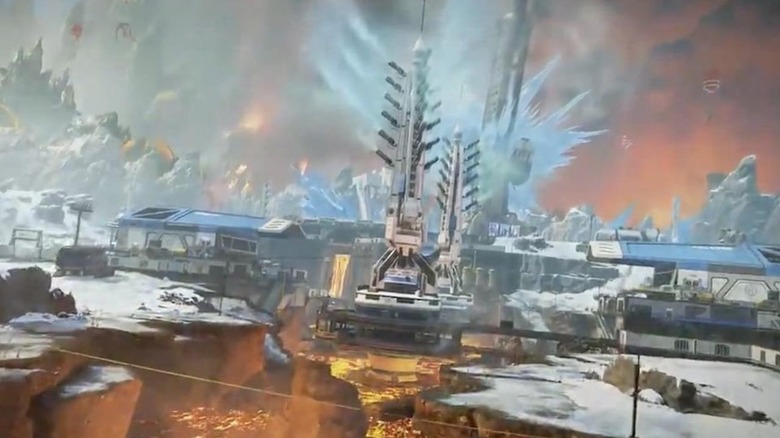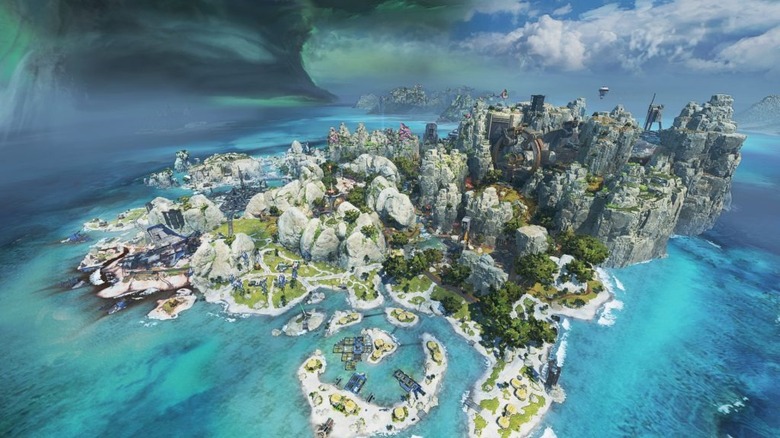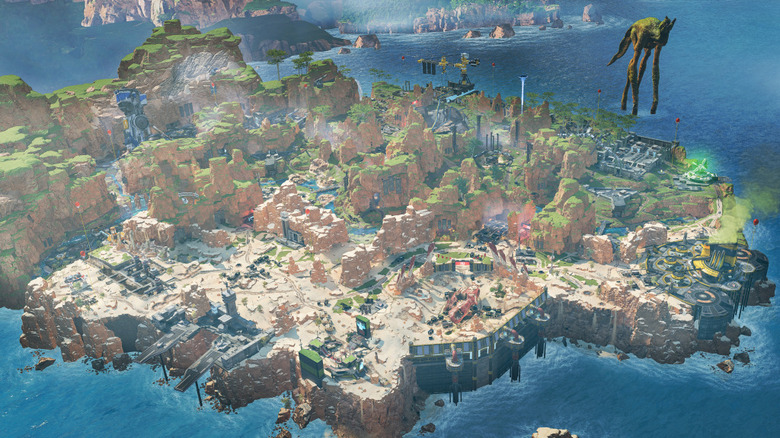Every Apex Legends Battle Royale Map, Ranked
Respawn's battle royale "Apex Legends" has been around for a few years now, and over time it's gone from only having one battle royale map to four, and there's even more when one counts arena maps in "Apex Legends," too. The maps are rarely the same between seasons, as each has seen updates that fundamentally alter the layout or features players must navigate through. For example, the infamous Skull Town sub-zone of King's Canyon has been removed and re-added several times, and several sub-areas on Olympus became overgrown during the Season 9 Legacy update.
The battle royale mode in "Apex Legends" has four maps. The first released was King's Canyon, then a few months later, World's Edge was introduced as an alternate map in Season 3. In Season 7, Olympus made its debut, and finally arriving alongside Season 11 was Storm Point. Not all "Apex Legends" maps are created equally, though; over the years, some have become more favored by players than others.
Here's a rundown of all the current maps available in the "Apex Legends" battle royale mode and which stands above the rest.
4 - World's Edge
World's Edge made its debut early on in the "Apex Legends" timeline alongside Season 3. Located on the planet Talos — Bloodhound's home planet — it features a vibrant array of locations that give "Apex Legends" squads strategic options no matter where they are on the map. Plus, it's home to Bloodhound's Trials, an "Apex Legends" area that goes beyond the norm by giving players a minigame to complete. Despite this, it comes fourth in this ranking of battle royale maps for two reasons: How spread out everything is and Fragment.
World's Edge has many great locations with various ways to navigate around other squads, but aside from Fragment, there's a lot of empty space between these sub-areas. Fragment acts like a funnel, drawing players in no matter where they land. It simultaneously serves as a magnet for squads that like to hot drop – more often than not, almost half the server will drop into Fragment at the start of the match. This can be a blessing, as fewer people get in the way when exploring, but ultimately it just means the squad that survives the onslaught will be incredibly well geared for the rest of the round.
3 - Storm Point
Storm Point is the most recent map added to "Apex Legends," but it's not necessarily the best. It is set on the planet Gaea, the homeworld of Caustic, Crypto, and Rampart, and its naming after the ancient Greek titan Gaia is no coincidence. It's the lushest map in "Apex Legends," so alive, in fact, that there are dozens of places where wild animals can spawn. Storm Point's flaws are similar to World's Edge, at least insofar as the map is spread out — though not to the same degree. On the other hand, the map has plenty of launch pads to get players across these long distances, so that does help make travel less tedious.
Storm Point has seen major updates since its initial release, but it hasn't dealt with its other main problem: how easy it makes ambushes. Like King's Canyon, Storm Point has lots of valleys and natural rock formations that players must maneuver as the ring closes. Unlike King's Canyon, though, these corridors are tight, leaving little room to get away if a third squad swoops in on two others for the killing blow. Storm Point beats out World's Edge because it gives players ways to get around better, but it loses points for how easy it is to get ambushed.
2 - Olympus
Olympus was added to "Apex Legends" in Season 7, alongside the gravity-defying legend Horizon. The map is essentially a city turned into a battleground for the Apex Games, and it introduced vehicles that players can use to get from place to place much more quickly. The setting is colorful and a significant departure from the more subdued palettes of King's Canyon, even after being reworked for the rough start of "Apex Legends" Season 9. Each sub-area feels completely different, with its own distinct flavor and design approach. The only thing holding Olympus back is that it heavily encourages long-range weapons over other choices.
At the end of almost every match on Olympus, the final ring closes on two or three squads who hole up and try to see who can spot the other team's snipers first. It's a shame because the map is designed for players to navigate around and take fights to close-quarters areas easily. That said, it's almost always safer for groups to simply get to high ground and pick off enemies. Olympus is well balanced and has lots of areas that are visually satisfying or fun to explore, but it could use more cover to break up the long-range meta.
1 - King's Canyon
King's Canyon is the OG "Apex Legends" map, debuting alongside the game on release. The initial map was very different from the current iteration of King's Canyon in Season 14, but it's seen plenty of updates to keep it fresh over the years. King's Canyon is the perfect "Apex Legends" map because it has just enough of everything to keep games exciting round after round. There are long-range areas, like the western desert and the area surrounding The Cage, but also plenty of more detailed places to navigate, like Caustic's funhouse and the canyons themselves.
No one playstyle outshines another on King's Canyon, but that doesn't mean the map is entirely without flaws. King's Canyon's color palette is severely lacking, for example, and it used to have a problem much like the one World's Edge currently faces. Skull Town used to attract most of the match's players every round and leave the rest of the map practically empty. Skull Town has periodically been removed and added back to King's Canyon over the years, but other areas on the map have improved so radically that it doesn't matter as much as it used to. Although it's the oldest map in the game, King's Canyon set the bar high and saw meaningful changes over the years. Now, it's a prime example of why "Apex Legends" is still worth playing.





